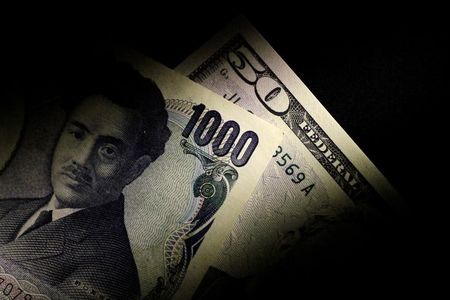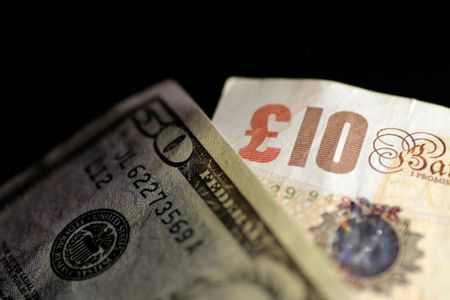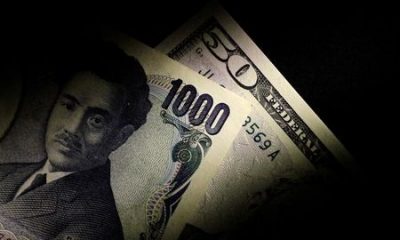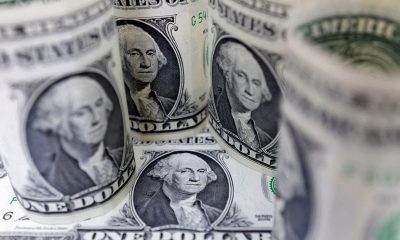Forex
Explainer-What would Japanese intervention to boost a weak yen look like?

By Leika Kihara
TOKYO (Reuters) -Japanese authorities are facing renewed pressure to combat a sustained depreciation in the yen, as traders drive down the currency on expectations that any further interest rate hikes by the central bank will be slow in forthcoming.
Below are details on how yen-buying intervention works:
LAST CONFIRMED YEN-BUYING INTERVENTION?
Japan bought yen in September 2022, its first foray in the market to boost its currency since 1998, after a Bank of Japan (BOJ) decision to maintain its ultra-loose monetary policy drove the yen as low as 145 per dollar. It intervened again in October after the yen plunged to a 32-year low of 151.94.
WHY STEP IN?
Yen-buying intervention is rare. Far more often the Ministry of Finance has sold yen to prevent its rise from hurting the export-reliant economy by making Japanese goods less competitive overseas.
But yen weakness is now seen as problematic, with Japanese firms having shifted production overseas and the economy heavily reliant on imports for goods ranging from fuel and raw materials to machinery parts.
WHAT HAPPENS FIRST?
When Japanese authorities escalate their verbal warnings to say they “stand ready to act decisively” against speculative moves, that is a sign intervention may be imminent.
Rate checking by the BOJ – when central bank officials call dealers and ask for buying or selling rates for the yen – is seen by traders as a possible precursor to intervention.
WHAT HAPPENED SO FAR?
Finance Minister Shunichi Suzuki told reporters on March 27 that authorities could take “decisive steps” against yen weakness – language he hasn’t used since the 2022 intervention.
remove ads
.
Hours later, Japanese authorities held an emergency meeting to discuss the weak yen. The meeting is usually held as a symbolic gesture to markets that authorities are concerned about rapid currency moves.
After the warnings failed to arrest the yen’s fall, South Korea and Japan won acknowledgement from the United States over their “serious concerns” about their currencies’ declines in a trilateral meeting held in Washington last week.
The market impact of the agreement did not last long. The dollar continued its ascent and notched a 34-year high of 155.74 yen on Thursday, driving past the 155 level seen as authorities’ line in the sand for intervention.
NEXT LINE IN THE SAND?
Authorities say they look at the speed of yen falls, rather than levels, and whether the moves are driven by speculators, to determine whether to step into the currency market.
While the dollar has moved above the psychologically important 155 level, the recent rise has been gradual and driven mostly by U.S.-Japanese interest rate differentials. That may make it hard for Japan to argue that recent yen falls are out of line with fundamentals and warrant intervention.
Some market players bet Japanese authorities’ next line in the sand could be 160. Ruling party executive Takao Ochi told Reuters the yen’s slide towards 160 or 170 to the dollar could prod policymakers to act.
WHAT’S THE TRIGGER?
The decision is highly political. When public anger over the weak yen and a subsequent rise in the cost of living is high, that puts pressure on the administration to respond. This was the case when Tokyo intervened in 2022.
remove ads
.
Prime Minister Fumio Kishida may feel the need to prevent further yen falls from pushing up the cost of living with his approval ratings faltering ahead of a ruling party leadership race in September.
But the decision would not be easy. Intervention is costly and could easily fail, given that even a large burst of yen buying would pale next to the $7.5 trillion that change hands daily in the foreign exchange market.
HOW WOULD IT WORK?
When Japan intervenes to stem yen rises, the Ministry of Finance issues short-term bills, raising yen it then sells to weaken the Japanese currency.
To support the yen, however, the authorities must tap Japan’s foreign reserves for dollars to sell for yen.
In either case, the finance minister issues the order to intervene and the BOJ executes the order as the ministry’s agent.
CHALLENGES?
Japanese authorities consider it important to seek the support of Group of Seven partners, notably the United States if the intervention involves the dollar.
Washington gave tacit approval when Japan intervened in 2022, reflecting recent close bilateral relations.
Finance Minister Suzuki said last week’s meeting with his U.S. and South Korean counterparts laid the groundwork to act against excessive yen moves, a sign Tokyo saw the meeting as informal consent by Washington to intervene as needed.
U.S. Treasury Secretary Janet Yellen said currency interventions should occur only in “very rare and exceptional circumstances,” when markets are disorderly with excessive volatility. She declined to comment on the yen’s value.
A looming U.S. presidential election may complicate Japan’s decision on whether and when to intervene.
remove ads
.
In a social media post on Tuesday, Republican presidential candidate Donald Trump decried the yen’s historic slide against the dollar, calling it a “total disaster” for the United States.
There is no guarantee intervention will effectively shift the weak-yen tide, which is driven largely by expectations of prolonged low interest rates in Japan. BOJ Governor Kazuo Ueda has dropped hints of another rate hike but stressed that the bank will tread cautiously given Japan’s fragile economy.
Forex
More yen weakness likely – BOA Securities survey

Investing.com – More Japanese yen weakness looks likely, according to Bank of America Securities, citing its latest foreign exchange and rates sentiment survey.
At 10:25 ET (14:25 GMT), traded 0.2% higher at ¥155.83, with the pair having gained just under 2% this week as yen weakness returned.
Japanese authorities are seen having spent almost $60 billion the previous week pulling the yen away from a 34-year-low of ¥160.24 versus the dollar.
The bank’s survey has shown a consistently bullish yen bias since mid-2022, analysts at BOA Securities said, until now.
With USDJPY breaching new highs in April, investors have flipped to the largest JPY short since 2022, and there is a deep scepticism around the effectiveness of Japan’s FX intervention.
The bank said the majority of fund managers polled expect USDJPY to retest ¥160, with no one expecting a reversal to ¥150.
“While we generally share these views, the volte-face on JPY perhaps warrants near-term caution for shorts,” the bank added.
Forex
Dollar calm at end of week; sterling gains on growth data

Investing.com – The U.S. dollar steadied Friday after losing ground the previous session on weak jobs data, while the pound gained in the wake of stronger-than-expected growth numbers.
At 04:10 ET (08:10 GMT), the Dollar Index, which tracks the greenback against a basket of six other currencies, traded just higher at 105.115.
Dollar on track for small gains this week
The dollar steadied Friday, and is course for minor gains this week after losses on Thursday following the release of data showed a bigger-than-expected increase in weekly j.
This evidence of a cooling U.S. labor market reinforced some expectations that the will begin cutting interest rates by September.
However, sticky inflation remains a key point of contention for the Fed, with a slew of officials warning as much this week, comments which boosted the dollar this week.
There is “considerable” uncertainty about where U.S. inflation will head in coming months, San Francisco Federal Reserve President Mary Daly said on Thursday.
“In a scenario where inflation stays … level, just doesn’t make much further progress, then it’s not appropriate to start adjusting the rate unless we see the labor market faltering,” she added.
These comments put upcoming data, due next week, squarely in focus for more cues on interest rates.
Sterling benefits from strong growth data
In Europe, gained 0.1% to 1.2534, recovering from its lowest level since April 24 on Thursday, after data released earlier Friday showed that Britain’s economy grew by the most in nearly three years in the first quarter of 2024.
remove ads
.
U.K. expanded by 0.6% in the three months to March, the strongest growth since the fourth quarter of 2021, as the country’s economy exited the shallow recession it entered in the second half of last year.
On a monthly basis, the grew by 0.4% in March, faster than the 0.1% growth forecast.
The held interest rates at a 16-year high on Thursday, but two of the nine-person Monetary Policy Committee voted for a cut, suggesting that the central bank is moving towards such a reduction.
traded largely unchanged at 1.0783, with a light data calendar providing little impetus.
The has all but promised a rate cut on June 6, but uncertainty exists over how many further cuts the central bank will agree to this year.
Pierre Wunsch, Belgium’s central bank governor, made the case for further moves earlier this week, arguing that staying tight for too long was now a bigger risk than easing too early.
Markets currently price in 70 basis points of rate hikes for this year.
USD/JPY drifts higher
In Asia, rose 0.2% to 155.70, trading well above lows of 152 it had hit earlier in May.
Traders now see the 160 level as the new line in the sand for Japanese government intervention.
rose 0.1% to 7.2249, with the yuan weakening following reports saying U.S. President Joe Biden was considering imposing fresh sanctions on certain Chinese industries, such as electric vehicles and batteries.
remove ads
.
While the economic impact of the tariffs was unclear, such measures could attract retaliation from China, further souring ties between the world’s two biggest economies.
Forex
Asia FX weak with US inflation in sight; China tariff fears dent yuan

Investing.com– Most Asian currencies moved little on Friday as the dollar steadied from overnight declines, with focus turning squarely towards key U.S. inflation data due next week, which is likely to provide more cues on interest rates.
The Chinese yuan declined, as did currencies with trade exposure to China after multiple reports said that the U.S. was preparing more trade tariffs on Beijing.
Regional currencies took little support from an overnight decline in the dollar, as more signs of a cooling labor market reinforced bets that the Federal Reserve will cut rates in September.
But the dollar steadied in Asian trade, pressuring regional currencies as uncertainty ahead of key U.S. inflation data next week kept traders largely biased towards the greenback.
Chinese yuan weakens, USDCNY up on tariff reports
The Chinese yuan’s pair rose 0.1% as multiple reports said U.S. President Joe Biden was considering imposing fresh sanctions on certain Chinese industries, such as electric vehicles and batteries.
While the economic impact of the tariffs was unclear, such measures could attract retaliation from China, further souring ties between the world’s two biggest economies.
Other currencies with trade exposure to China fell tracking this notion. The Australian dollar’s pair fell 0.2%, while the Singapore dollar’s and the South Korean won’s pairs lost 0.1% and 0.3%, respectively.
Japanese yen remains fragile, USDJPY nears 156
Weakness in the Japanese yen persisted this week, as the pair recouped a bulk of its losses made after the government seemingly intervened in currency markets last week.
remove ads
.
The USDJPY pair rose 0.2% to 155.73 yen, trading well above lows of 152 it had hit earlier in May. Traders now saw 160 yen as the new line in the sand for Japanese government intervention.
Household spending data for March, released earlier on Friday, showed some resilience- a trend that could potentially underpin Japanese inflation expectations.
Dollar steadies, set for weekly gains ahead of inflation data
The and rose slightly in Asian trade, recovering a measure of overnight losses. But the greenback was still trading up about 0.2% for the week.
The greenback fell on Thursday after data showed a bigger-than-expected increase in weekly , furthering expectations of a cooling U.S. labor market.
This reinforced some expectations that the Fed will begin cutting interest rates by September.
But sticky inflation remained a key point of contention for the Fed, with a slew of officials warning as much this week.
Their comments put upcoming data, due next week, squarely in focus for more cues on interest rates.

 Forex2 years ago
Forex2 years agoForex Today: the dollar is gaining strength amid gloomy sentiment at the start of the Fed’s week

 Forex2 years ago
Forex2 years agoHow is the Australian dollar doing today?

 Forex1 year ago
Forex1 year agoUnbiased review of Pocket Option broker

 Forex2 years ago
Forex2 years agoDollar to pound sterling exchange rate today: Pound plummeted to its lowest since 1985

 Cryptocurrency2 years ago
Cryptocurrency2 years agoWhat happened in the crypto market – current events today

 World2 years ago
World2 years agoWhy are modern video games an art form?

 Stock Markets2 years ago
Stock Markets2 years agoMorgan Stanley: bear market rally to continue

 Economy2 years ago
Economy2 years agoCrude oil tankers double in price due to EU anti-Russian sanctions

































